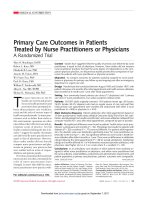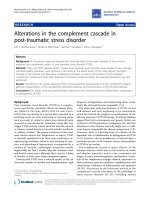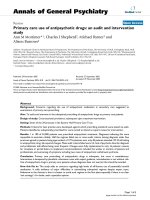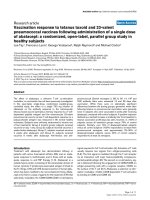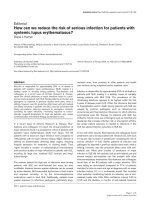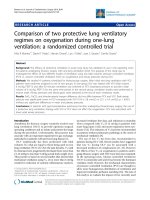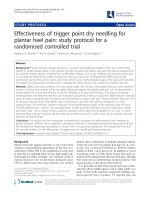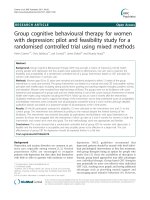Báo cáo y học: "Intensive care diaries reduce new onset post traumatic stress disorder following critical illness: a randomised, controlled trial" docx
Bạn đang xem bản rút gọn của tài liệu. Xem và tải ngay bản đầy đủ của tài liệu tại đây (546.98 KB, 10 trang )
RESEARC H Open Access
Intensive care diaries reduce new onset post
traumatic stress disorder following critical illness:
a randomised, controlled trial
Christina Jones
1,2
, Carl Bäckman
3
, Maurizia Capuzzo
4
, Ingrid Egerod
5
, Hans Flaatten
6
, Cristina Granja
7
,
Christian Rylander
8
, Richard D Griffiths
1,2*
, the RACHEL group
Abstract
Introduction: Patients recovering from critical illness have been shown to be at risk of developing Post Traumatic
Stress disorder (PTSD). This study was to evaluate whether a prospectively collected diary of a patient’s intensive
care un it (ICU) stay when used during convalescence following critical illness will reduce the development of new
onset PTSD.
Methods: Intensive care patients with an ICU stay of more than 72 hour s were recruited to a randomised
controlled trial examining the effect of a diary outlining the details of the patients ICU stay on the development of
acute PTSD. The intervention patients received their ICU diary at 1 month following critical care discharge and the
final assessment of the development of acute PTSD was made at 3 months.
Results: 352 patients were randomised to the study at 1 month. The incidence of new cases of PTSD was reduced
in the intervention group compared to the control patients (5% versus 13%, P = 0.02).
Conclusions: The provision of an ICU diary is effective in aiding psychological recovery and reducing the
incidence of new PTSD.
Trial registration: NCT00912613.
Introduction
ICU survivors, even with differ ing presenting diagnoses,
have been shown to face common psychological pro-
blems during their recovery, including anxiety, depres-
sion and post-traumatic stress disorder (PTSD). PTSD is
a condition triggered by the experience of a traumatic
event [1], which must be severe enough to cause power-
ful subjective responses such as intense fear, helpless-
ness and horror. It is characterised by a range of
symptoms such as re-experiencing the event (flash-
backs), avoidance of situations that remind one of the
event, a numbed reaction and symptoms of increased
arousal. The incidence of PTSD varies across different
studies and units [2], but few studies have used a well-
recognised diagnostic tool. One study using such a tool
showed that on average 1 in 10 patients, who stay more
than 48 ho urs in the ICU, will have the diagnosis [3].
The full diagnosis of PTSD is made if the symptoms the
individuals are experiencing make it difficult for them to
function in domains o f their normal life, such as rela-
tionships or work. This has a significant impact on their
quality of life leading to social isolation, marital pro-
blems, unemployment and long-term health problems,
such as asthma, arthritis, headache, ulcers and cardio-
vascular problems [4]. Research suggests t hat the earlier
treatment is provided the less the likelihood of patients
going on to develop chronic PTSD [5].
The fragmentary nature of memories for the time in
critical care and the high proportion of delusional mem-
ories, such as nightmares and hallucinations, that are
recalled afterwards make it difficult for patients to make
sense of what has happened to them [6] and has been
shown to be one of the precipitants of P TSD in this
population [3,7,8]. These memories are frequently
described by patients as very vivid, realistic and
* Correspondence:
1
ICU, Whiston Hospital, Warrington Road, Prescot L35 5DR, UK
Full list of author information is available at the end of the article
Jones et al. Critical Care 2010, 14:R168
/>© 2010 Jones et al.; licensee BioMed Central L td. This is an open access article distributed under the terms of the Creative Commons
Attribution License ( which permits unrestri cted use, distribution, and reproduction in
any medium, provided the original work is properly cited.
frightening and may even involve patients thinking that
nurses or doctors tried to kill them [6].
The u se of an ICU diary with pho tographs started as
an aid to fill in the gaps in patients’ memories. A num-
ber of studies have shown that ICU diaries are well
accepted by patients and families [9,10]. However,
research into their possible role in a iding p sychological
recovery following critical illness is limited. One small
randomised study (n = 36), has shown reduced depres-
sion and anxiety in those patients receiving a diary [11].
In our observational study of the pre cipitants associated
with PTSD we noticed lower levels of PTSD-related
symptoms in those patients receiving a diary [12]. We
hypothesised that a diary explaining what happened to
the patient in the ICU might help them fill in the signif-
icant gaps they have in their memories and put any
delusional memories into context and so aid psychologi-
cal recovery. It is possible that the ICU diary allows
patients to change how they think about their experi-
ence of the ICU by providing a coherent narrative that
can then be assimilated into autobiographical memory
by rereading the diary over the months after their ICU
discharge and so reducing the distress felt. The guide-
lines from the UK National Institute for Health and
Clinical Excellence [13] for the treatment of PTSD
recom mend cognitive behavioural therapy (CBT). Chan-
ging how clients think about their traumatic experience
is one of the aims of CBT.
The primary aim of the study was to test whether the
provision of an ICU diary reduces the occurrence of
new cases of PTSD (excluding those patients with pre-
existing PTSD), particularly where patients’ recall delu-
sional memories.
Materials and methods
Protocol
The study was conducted in six general district hospitals
and six university hospitals in six European countries.
All hospitals in the study had prior experience with ICU
diaries. Al l the individual hospitals gai ned ethical
approval from their local research ethics committees
and the research was carried out in compliance with the
Helsinki Declaration.
The inclusion criteria were that the patients had been
in the ICU and ventilated. Patients were excluded if
they: stayed in the ICU for less than 72 hours; were ven-
tilated for less than 24 hours; were too confused to give
informed consent (including severe traumatic brain
injury); and had pre-existing psychotic illness such as
schizophrenic and manic depression (a confounding fac-
tor for psychological recovery) or diagnose d PTSD. As
our previous study had shown that patients may already
have all the symptoms required for a diagnosis of PTSD
prior to ICU admission without this being previously
recognised [3], the study protocol planned for the data
analysis to only include patients with a new diagnosis of
PTSD, excluding those subsequently recognised to have
had previous non-ICU-related chronic PTSD. We
decided to include patients with previous history of
minor psychological problems, such as anxiety and
depression, because this factor has been demonstrated
to be associated with an increased risk of developing
PTSD [3]. The decision to include only patients staying
on the ICU for 72 hours and longer was both a logistical
one to ensure that a reasonable ICU diary was avai labl e
for the patient and because the risk of developing PTSD
has been shown to be greater the longer the period of
sedation [3].
The average number of patients admitted per unit in
the study per year was around 400, of whom only
around 100 were anticipated to stay for 72 hours and
longer and survive to be discharged home from hospital.
A minimum of 264 patients were required assuming: (a)
10% of patients suffered from new-onset PTSD [3]; (b) a
projected 10% loss or withdrawal rate; and (c) a signifi-
cance level of 5% and a power of 90%; and (d) a 50%
reduction in PTSD based on our previous non-rando-
mised study [12].
Treatment conditions
All patients had an ICU diary written for them while
they were in critical care, which the healthcare staff
wrote and the family contributed to if they felt they
could. The diary was a daily record of the patients’ ICU
stay, written in everyday language and accompanied by
photographs. To standardise the diaries as much as pos-
sible a set of guidelines were provided to each centre
[see Additional file 1]. The workload of writing in a
diary is minimal at only a few minutes per day, except
for starting the diary, which takes longer as an introduc-
tion is needed to explain why the patient had come to
the ICU. Each study unit had a diary group that took on
the burden of this. The patients were recruited to the
study on the general wards at about one week after dis-
charge from the ICU. Memories of the ICU were
assessed at one week post-ICU using the ICU Memory
Tool (ICUMT) [13], because recall of delusional mem-
ories (e.g. hallucinations and nightmares) from ICU
assessed at this time point has been previ ously shown to
be associated with new-onset PTSD [3]. The patients
were also asked about any previous psychological history
or previous history of undergoing traumatic events at
this time point and this was cross-referenced with their
clinical records.
Current best practice recommends that intervention
studies for PTSD should be undertaken only once an
initial a ssessment of symptom levels has b een taken so
ensuring that the study groups were comparable [14].
Jones et al. Critical Care 2010, 14:R168
/>Page 2 of 10
Baseline PTSD-related symptoms were assessed at one
month post-ICU, as per best practice recommendations
[15], just prior to randomisation to study group using
the Post-Traumatic Stress Syndrome 14 (PTSS-14)
screening tool [16]. The PTSS-14 was used at this time
point as it is short (5 to 10 minutes to complete), can
be used easily in an outpatient setting or over the tele-
phoneanddoesnotovertirepatientswhoarestillvery
weak. The patients were then randomised at one-month
post-ICU discharge to either receive their diary as soon
as they wanted (intervention) or after they completed
the final follow-up questionnaires at three months
(controls).
The diary containing photographs and hand written
text was introduced to the patient by a research nurse
or doctor who ensured that they understood its contents
but did not give any advice on what to do with it. Most
of the discussions took place in an outpatient setting in
a hospital but a small number were in the patients’ own
home. In units where the travelling distance was too
great for the patient to return to the hospital the discus-
sion of the diary took place over the phone. The diary
was sent by registered post to the patient with a letter
telling them not to read it and a date and time when
the nurse would phone them and go through it with
them using a photocopy. No other post-hospital contact
was made until returning to the hospital or a phone
interview at three months for formal diagnostic testing.
Outcome measures
All the tools used in the study have been used in the
ICU population before [3] and are well validated [15],
the RACHEL (Raising Awareness, after Critical illness,
of adverse Health Events in the Long-term) research
group rechecked the validity of all the tools in transla-
tion in a previous multi-national study [3]. The ICUMT
consists of 14 items that investigates the recall of hospi-
tal, ICU admission and discharge. A checklist of mem-
ories is included to increase the recall of ICU and the
patient confirms their presence or absence. Baseline
PTSD-related sympto ms were assessed using the PTSS-
14 screening tool, which is a 14-item que stionnaire that
has b een validated with ICU patients [15] with concur-
rent validity (r = 0.86) against the PTSD Diagnostic
Scale (PDS). Receiver operator curve analysis suggested
the highest levels of sensitivity (86%) and specificity
(97%) for diagnosis of PTSD, with an optimum decision
threshold of 45 points and this was used to stratify the
patients for analysis of PTSD-related symptom change.
At three-months post-ICU, the PDS [17] was performed
as the endpoint of the study. The PTSS-14 screening
tool was also repeated. The PDS was administered as a
diagnostic interview with the patient and allowed stan-
dardisation of the diagnosis of PTSD [17]. Moreover, it
identifies the traumatic event responsible for symptoms
as well as the time of the beginning of symptoms. It is
one of the few measures in the P TSD literature that
assesses all criteria (A - F), including functional impair-
ment [18]. It also allows assessment of the severity of
the patients’ symptoms for each o f the three PTSD
symptom clusters, that is, re-exp eriencing, avoidance
and physiological arousal. The higher the scores in the
separate categories then the more severe the symptoms
are. In the original valida tion paper [17] PTSD patients
had a mean score of 8 .95 for re-experiencing, 13.63 for
avo idance and 11.0 2 for arousal. The original validation
study showed a sensitivity of 82% and a specificity of
76.7%, showing a good overall level of diagnostic agree-
ment with a clinical interv iew method of diagnosing
PTSD [17]. This tool was chosen to standardise the
assessment of PTSD across all the centres rather than
relying on possibly variable clinical assessment by 12
different psychologists. An a lternative would have been
to use a standardised clinical interview but this would
have b een prohibitive i n terms of resources. All centres
were visited by one of the authors prior to their starting
patient recruitment to ensure the tools were all adminis-
tered in a consistent way.
It was impractical to guarantee blinding of the alloca-
tion of the diary as patients would volunteer their use.
In order to reduce bias and ensure blinding of the d iag-
nosis of PTSD at the three-month follow-up the
researchers were only trained to interview and adminis-
ter the PDS but were not made aware of the scoring cal-
culation or in what way each question c ontributed to
the score and final diagnosis. This calculation was per-
formed by computer only at final analysis before the
study code was broken. No interim analysis was planned
or stopping rules designed as the intervention was
already in widespread use and felt to be safe.
All tools had been previously translated into Swedish,
Norwegian and Italian and checked for accuracy by back
translation [3]. They were also translated into Danish
and Portuguese and checked by back translation. The
control group were able to receive their diary once the
three-month questionnaires were completed. Those
patients assessed using the PDS to have pre-morbid
chronic PTSD (symptoms for more than three months
after a traumatic event) prior to admission to ICU
(often not previously diagnosed or labelled as anxiety)
were excluded from the final analysis of new PTSD.
These patients were recognised as they reported symp-
toms from some years before the ICU admission and
with a different precipitant. It is not feasible so soon
after ICU discharge when recruitment to this study
occurred to have reliably undertaken the detailed PDS
assessment required to exclude these previously undiag-
nosed patients with pre-existing chronic PTSD.
Jones et al. Critical Care 2010, 14:R168
/>Page 3 of 10
All patients had their illness severity assessed using an
acute physiology and chronic health evaluation
(APACHE) II score calculated for the day of admission
to ICU. Length of ICU stay, admission diagnosis group,
age and gender were also recorded.
Study time points
At one to two weeks after ICU discharge, t he patients
completed the ICUMT. At one month they completed
the PTSS-14 and w ere then randomised to the study
group. At three months the PTSS-14 was repeated and
the PDS completed.
Assignment
The study was a block randomised controlled trial of the
impact of receiving an ICU diary at one month within
the first three months of recovery. The primary efficacy
outcome was the occurrence of new-onset PTSD at
three months post-ICU discharge (excluding those
patients meeting the diagnostic criteria of chronic PTSD
where the causation and symptoms pre-date the admis-
sion to ICU by more than three months).
Patients were recruited to the study one week after
ICU discharge, when still on the general wards. Patients
were assigned to treatment or control group at one
mont h using a closed, non-transparent envelope techni-
que, randomised in blocks of six through computerised
random number generation. Data was entered directly
onto an excel database in each study site with the ran-
domisation status coded. Once the study closed, t he
data quality was checked and the database then locked.
Data analysis was performed bli nd using coded data and
the code only broken once the analysis was complete.
Statistics
The statistical analysis was performed by one of the
authors (CJ; who was not involved in the recruitment or
follow-up of the study patients) using SPSS for Win-
dows, version 14.0 (SPSS Inc, Chicago, Ill inois, USA).
Questionnaire data were treated as ordinal and analysed
using non-parametric statistics [19]. Non-parametric sta-
tistics were used with interval data, for example , age
[20]. However, parametric statistics were used with ordi-
nal data if the variances across groups were approxi-
mately the sa me. The Levene statistic tested for equality
of group variances. Clinical descriptors were used for
comparison between control and interventio n groups to
ensure adequate randomisation. T tests and Mann
Whitney U tests were employed when comparing two
groups and univariate analysis of variance (ANOVA)
using the F statistic to test group (>2) comparisons. The
Scheffé post hoc test (set at P<0.05) was used for multi-
ple comparisons. However, when the distribution was
poor, the data were subjected to the distribution free
equivalent method (Kruskal-Wallis one-way ANOVA for
independent groups). Proportions were tested using
Fisher’s exact test. The PTSD outcome data are analysed
based on new-onset PTSD after excluding those with
established chronic PTSD.
Results
Participant flow and follow- up
Recruitment at the 12 ICUs ran over a 12-month period
between 2006 to 2008 with three months for follow-up,
with a staggered start for each unit to ease training and
supervision by the lead author (CJ). The Consort dia-
gram (Figure 1) shows 1,164 eligible patients, 309 died
in ICU or shortly after discharge, 65 refused to take part
and 433 were excluded because of previous psychotic
illness (n = 6), attempted suicide (n = 3), age younger
than 16 years (n = 2), distance too great for follow-up
(n = 10), transferred to another ICU (n = 274) or unre-
solving confusion at one to two weeks post-ICU admis-
sion (n = 138). At one-month post-discharge from ICU,
352 patients were randomised to the study and, of these
patients, 333 completed their three-month follow-up
questionnaires (see CONSORT diagram Figure 1). Three
control and eight intervention patients were found to
have previ ously undiagnosed pre-existing chronic PTSD
using the PDS. Only two of these patients rated their
ICU stay as being one of the traumatic events in their
lives on the PDS (one control and one intervention) and
all named an earlier event as the most traumatic event
and had had PTSD symptoms for three to five years
prior to their ICU admission. Five controls and three
intervention patients died between the one and three-
month follow-up, and seven controls and four interven-
tion patients withdrew from the study. There was no
difference in the one-month PTSS-14 between those
who completed the study and those who dropped out
(median PTSS-14 score 24 co mpleted vs 28 for drop-
outs, Mann-Whitney U P = 0.34). Of 177 intervention
patients, 162 (91.5%) and of 175 controls 160 (91.4%)
completed the three-month follow-up questionnaires
and did not have pre-existing chronic PTSD. No adverse
events were encountered during the study period.
Study group comparisons
Following randomisation, there was no difference
between the two study groups for age, length of ICU
stay, hours ventilated, APACHE II, history of previous
psychological problems or traumatic experiences, recall
of delusional memories at one week or PTSD-related
symptom levels using the PTSS 14 score at one month.
However, there were more female patients randomised
to the control group, 71 (41%) versus 54 (31%) in the
intervention group (Table 1). The incidence of PTSD
when examined in the control group was not found to
Jones et al. Critical Care 2010, 14:R168
/>Page 4 of 10
be related to gender (12% in both males and females,
Fisher’s exact test P = 0.92). 49% of the controls and
51% of the intervention patients reported delusional
memories from their time in ICU. The PTSS-14 scores
at one month were statistic ally higher (Mann Whitney
U P = 0.013) in those patients recalling delusional
memories.
Analysis of effect of diaries
When pre-existing chronic P TSD, w ithdrawals and
death were excluded, fewer intervention patients,
compa red with controls, were diagnosed as having new-
onset PTSD at three months, 8 of 162 (5%) versus 21 of
160 (13.1%) (chi-squared = 7.15, P = 0.02; Table 2). This
is despite 70 of 162 (43.2%) intervention pa tients and 76
of 160 (47.5%) controls reporting on the PDS that they
found their ICU experience traumatic and so fulfilled
criterion A for PTSD. Of the intervention patients, 87%
received their diary at randomisation with the rest
receiving theirs o ver the next month, leaving most with
two months to reread the diary and 5% with one month
before the three-month follow-up.
Figure 1 CONSORT diagram of recruitment and follow-up.
Jones et al. Critical Care 2010, 14:R168
/>Page 5 of 10
Change in PTSD symptoms
WhenthechangeinthePTSS-14scoresbetweenone
and three months was examined for all the patients com-
pleting the follow-up there was no overall difference
between the controls and interventions (Mann Whitney
U P = 0.737). However, in a post-hoc analysis, when the
literature cut-off score of 45 or more [16] was applied, 12
intervention and 14 control patients scored in this range
at one month. By the three-month follow-up there was a
significant reduction in the PTSS-14 score for those scor-
ing 45 or more at one month in the intervention group
(Mann Whitney U test P =0.04;Figure2).Themedian
change in the score for t hose intervention patients
scoring very highly for PTSD-related symptoms between
oneandthreemonthswas-23, showing a significant
reduction compared with the equivalent controls which
was -2.
Patients’ comments
Patient feedback about the diaries was very positive with
most of the intervention patients receiving the diary at
the one-month follow-up and reading it a median of
three times (0 to 20 range). Only one patient had not
read the diary. Of the intervention patients, 148 (84%)
said that others had read the diary, most commonly the
family (100%), friends (36%), colleagues (5%) and
Table 1 Comparison of patient characteristics across study groups
1 month randomisation 3-month follow-up
Study group P values Study group P values
Variables (median, range) Control (n = 175) Intervention (n = 177) Control (n = 160) Intervention (n = 162)
Age 59 (18-82) 60 (18-81) NS 59 (± 16) 60 (± 15.5) NS
ICU stay (days) 13 (3-71) 13 (3-79) NS 13 (± 11.6) 13.8 (± 12.7) NS
Hours ventilated 240 (24-1200) 212 (24-1500) NS 240 (± 242) 216 (± 233) NS
APACHE II severity score 18 (2-39) 20 (5-46) NS 19 (± 6.5) 20 (± 7.3) NS
Total PTSS 14 score at 1 month 25 (13-65) 22.5 (14-84) NS 24 (± 11.6) 24 (± 12.2) NS
Variables (n, percentage)
Previous psychological problems 51 (29%) 51 (29%) NS 43 (27%) 41 (27%) NS
Previous traumatic experiences 38 (22%) 32 (18%) NS 34 (22%) 25 (16%) NS
Recall of delusional memories 91 (52%) 96 (54%) NS 81 (52%) 85 (55%) NS
Emergency admission to ICU 163 (93%) 157 (89%) NS 149 (93%) 143 (88%) NS
Gender (Male/female) 104/71 123/54 0.045 100/60 110/52 NS
Diagnostic groups (n, percentage)
Respiratory failure 41 (23%) 35 (20%) NS 35 (23%) 27 (18%) NS
Sepsis 33 (19%) 21 (12%) NS 31 (20%) 19 (12%) NS
Circulatory failure 22 (13%) 22 (12%) NS 17 (11%) 19 (12%) NS
Multi-organ failure 20 (11%) 30 (17%) NS 18 (11%) 24 (16%) NS
Trauma (Total) 24 (14%) 27 (15%) NS 23 (15%) 25 (16%) NS
Multiple trauma without head injury 19 (11%) 14 (8%) NS 19 (11%) 13 (8%) NS
Multiple trauma with head injury 2 (1%) 7 (4%) NS 2 (1%) 7 (4%) NS
Isolated head injury 2 (1%) 5 (3%) NS 2 (1%) 4 (3%) NS
Other trauma 1 (0.5%) 1 (0.5%) NS 0 (0%) 1 (0.5%) NS
Combined (pulmonary/circulatory) 18 (10%) 19 (11%) NS 16 (10%) 19 (11%) NS
Gastrointestinal failure 8 (5%) 14 (8%) NS 7 (5%) 13 (8%) NS
Neurological failure 6 (3%) 5 (3%) NS 5 (3%) 4 (3%) NS
Other reasons 3 (2%) 3 (2%) NS 3 (2%) 1 (2%) NS
Planned 0 (0%) 1 (0.5%) NS 0 (0%) 1 (0.5%) NS
APACHE, acute physiology and chr onic health evaluation; NS, not statistically significant; PTSS, post-traumatic stress syndrome.
Table 2 Results at three months by study group
Study group
Variables (number, percentage) Control (n = 160) Intervention (n = 162) P value
New-onset PTSD 21 (13.1%) 8 (5%) 0.02*
ICU seen as traumatic (PDS) 76 (47.5%) 70 (43.2%) 0.36
*Chi-squared test. PDS, PTSD Diagnostic Scale; PTSD, post-traumatic stress disorder.
Jones et al. Critical Care 2010, 14:R168
/>Page 6 of 10
healthcare staff (4%). When asked what the interven tion
patients felt hel ped most, only two (1.4%) patients men-
tioned the meeting with the nurse, 66 (49%) felt reading
the text in the diary was most helpful, 49 (36%) thought
the combination of photographs and text and 21 (15%)
thought the photographs helped most.
Discussion
Our hypothesis was that a diary explaining what hap-
pened to the patient in ICU might help patients fill in
gaps in their memories, place any delusional memories
into context and aid psychological recovery. The study
showed that the provision of an ICU diary, outlining the
patients’ stay in ICU on a day to day basis, given at one
month into the patients’ recovery helps to reduce the
incidence of new acute-onset PTSD reducing its impact
on the patients’ long-term quality of life [21]. ICU
patients developing PTSD may be haunted by their
memories and may try to suppress them; however, try-
ing n ot to think about such emotionally charged mem-
ories leads to more unbidden thoughts accompanied by
greater physiological arousal [22]. Learning to modulate
their feelings and reduce the physiolo gical arousal is the
first step to recovery. CBT is recommended for the
treatment of PTSD and a similar mechanism may be
operating with the diaries because it helps patients to
change how they think about their illness as they reread
the story and build an autobiographical memory.
There was one slight difference between the study
groups at randomisation; there were more females in
the control group and at least one study has suggested
that high levels of PTSD-related symptoms are more
common in women [23]. However, this is not a consis-
tent finding across studies [2] and in the control group
gender was not related to the development of PTSD in
this study.
Family members can suffer from PTSD themselves
[24] and may also be helped by the diaries because it
clarifies the story for them too and helps to facilitate
communication with the patient about their treatment.
In addition writing in the diary when the patient is in
ICU may allow them to express some of their feelings.
A strong relation has been found between high le vels of
PTSD-related symptoms in family me mbers and thos e
in patients [24] so a therapy, such as a diary, that is
shared between the patient and the family may be better
than one that just concentrates on the patient.
The mechanism behind the d evelopment of PTSD is
still not clear. Some researchers h ave focused on nora-
drenergicactivityasakeycomponentofthestress
response and tried to manipulate this to reduce the nor-
adrenergic activity and the enhanced startle response,
Figure 2 Change in PTSS-14 scores between one and three months by study group and PTSS-14 of 45 or more at one month. Patients
in the intervention group with a post-traumatic stress syndrome (PTSS)-14 score above the cut-off of 45 at one month had a significant
reduction in the PTSS-14 symptom score at three months (Fisher’s exact test P = 0.04).
Jones et al. Critical Care 2010, 14:R168
/>Page 7 of 10
which is part of PTSD [25]. Other PTSD researchers
have suggested that the helplessness experienced at the
time of the trauma and the biological effects of being
unable to escape lead to the profound changes seen in
PTSD [26]. Ehlers and Clark’s [27] PTSD model
hypothesises that it is the quality of an individuals’ cog-
nitive processing during a traumatic event that is impor-
tant in the development of chronic PTSD. Those
individuals who rep ort feeling confusion and over-
whelmed as they experienced the traumatic situation are
more likely to suffer from chronic PTSD. ICU patients’
ability to process information is likely to be compro-
mised by a number of factors, such as critical illness,
delirium, sleep deprivation, sedative drugs and opiates.
They are likely to be unable to process t he meaning of
the events happening to them and may instead experi-
ence delusional events such as hallucinations or night-
mares and so be predisposed to high levels of chronic
PTSD. A number of studies have examined the influ-
ence of giving a b-adrenergic receptor antagonist [28,29]
or cortisol therapy [30-32] to try to reduce the incidence
of PTSD; however, these therapies may be problematic
in the critical care population and more research is
needed to clarify their role.
Concern has been expressed by some that the diaries
could be seen as a one-off debriefing session, which
have been shown to increase the risk of PTSD [33].
However, as many patient’s memories are fragmentary
and much contained in the diary is new to the patient,
this seems unlikely and is not supported by the results
of this study.
Diaries are not without cost; there has to be a com-
mitment from the staff to write something in the diary
every day and take photographs when important
changes happen. In addition an experienced nurse is
needed to go through the diary with the patient to
ensure that they understand its contents, but this is not
significantly more than might have been provided by an
unstructured discussion i n the past . However, compared
with prov iding formal CBT to all patients struggling to
cope with their experience this is likely to b e a cost-
effective therapy.
The study had a number of strengths but also limita-
tions and possibility of bias. One of its strengths is the
low attrition rate, which can be attributed to the use of
research staff with previous experience of following
patients up and the direct interview style method rather
than using postal questionnaires. In addition t he wide
recruitment across 12 ICUs facilitates the generalisability
of the results. It was not possible to fully blind the
receipt of the diary from the investigators because
patients will often mention them. However, the scoring
of the PDS is complicated and in components and is
therefore difficult to influence unconsciously. The
interviewing investigators were kept blind to the sepa-
rate sympt om group scores and the overall diagnosis of
PTSD. In addition the intervention patients had a dis-
cussion session with an experienced investigator to go
through the diary that could have influenced the results.
However, the current practice for both control and
study group patients at several of the study sites was to
give them verbal information about their illness prior to
discharge from hospital, which w ould have entailed a
similar discussion. This could be examined in further
studies. Another possible limitation is t he fact that not
all patients could get back to the hospital to receive
their diary or for the final interview due to travelling
distance and so these interviews were conducted by tele-
phone. This was a pragmatic study and tried to mimic
what would be normally done clinically. The maj ority of
study participants were interviewed face to face in a
hospital setting so the likelihood of this having an influ-
ence on the incidence of PTSD is not great. Finally, it
would have been preferable to have used the PDS at one
month so that patients with previous PTSD, not related
to their ICU stay, were recognised prior to randomisa-
tion and excluded. The PDS can take one hour to com-
plete and for some patients at one month this is still too
long for them to maintain concentration and give reli-
able information. This would also have been difficult
where the interview had to be conduc ted by telephone.
A compromise was to make the diagnosis based on the
three month PDS and exclude those patients with pre-
existing PTSD from the analysis.
The patients in this study reported finding both the
text and the photographs helpful in understanding their
illness. Thi s is a s imple and very practical intervention,
which this study shows is effective in reducing the inci-
dence of new PTSD after critical illness. The UK NICE
guidelines on the treatment of PTSD suggest that target-
ing at-risk groups rather than blanket interventions
should be practiced [12]. This w ould mean that ICU
patients would only receive a diary if they had high
levels of symptoms. However diaries have been seen
simply as a source of information for patients about
theirillnessandithasbeensuggestedthatallpatients
staying on the ICU for more than 48 hours should have
one [34]. In practice their use may fall somewhere in
the middle with the longer-stay patients likely to benefit
the most and being an achievable target. Those patients
with low levels of PTSD symptoms may still be happy
to receive the information it contains. The study shows
that those intervention patients scoring very highly for
PTSD symptoms using the PTSS-14 got the biggest
reductioninsymptomsbythreemonths,whereasthe
majority of those not scoring highly remained
unchanged. However, this was a post-hoc ana lysis result-
ing in a low number of patients for analysis. The fact
Jones et al. Critical Care 2010, 14:R168
/>Page 8 of 10
that when all the patients were examined there was no
significant difference between the two study groups in
the change in PTSS-14 scores between one and three
months is not surprising as only about 10% of the
patients scored more t han 45 on the PTSS-14 at one
month and the 90% of patients with lower scores
masked the result.
Thelowestoccurrenceofnew-onsetPTSDinthe
intervention patients is an important first step in helping
these patients to put their lives back together after criti-
cal illness.
Conclusions
The provision of an ICU diary was associated with a
reduction in the incidence of new-onset PTSD. Patient
feedback about their diary was very positive with the
majority reading it a number of times over the two-
month follow-up period. The lo wer occurrence of new-
onset PTSD in the intervention group is encouraging
and suggests that an ICU diary may represent an impor-
tant first step to hel p patients come to terms with t heir
experiences.
Key messages
• ICU diaries reduce new-onset PTSD following cri-
tical illness.
• Those patients with high levels of symptoms of
PTSD at one month post-ICU benefit most from the
diary in terms of reduction in new-onset PTSD.
• All the intervention patients were very positive
about their diary.
• For the majority of the intervention, patients
family, f riends, work colleagues and healthcare pro-
fessionals had also read the diary.
Additional material
Additional file 1: Patient diary guidelines. This contains the guidelines
used in the study to ensure all study centres wrote diaries in a similar
way.
Abbreviations
ANOVA: univariate analysis of variance; CBT: cognitive behavioural therapy;
ICUMT: ICU Memory Tool; PDS: the PTSD Diagnostic Scale; PTSD: post
traumatic stress disorder; PTSS-14: Post-Traumatic Stress Syndrome 14.
Acknowledgements
RACHEL GROUP in addition to the authors: Denmark, Christensen D, Bogø I,
Hansen R, Kjerrumgård H, Mathiasen L, Hyldested C, Toft C, Nordsjaelland
Hospital; Bagger C, Larsen MB, Frank de Jong L, Odense University Hospital;
Ågård AS, Knudsen K, Hinzel T, Århus University Hospital, Skejby; Italy,
Scaramuzza A & Bertacchini S, Ferrara; Norway, Schou Landmark J,
Salomonsen A, Tøien K, Walther S, Oslo University Hospital Ulleval; Muri AK,
Haukeland University Hospital; Portugal, Neutel E, Gomes E, Cardoso T,
Ferreira R, Machado C, Santos C, Pinto S, Hospital Santo António - Centro
Hospitalar do Porto, Amaro A, Morujão E, Jerónimo A, Rodrigues T, Carvalho
F, Silva A, Morais A Hospital Pedro Hispano; Sweden, Löwenmark U, Etemad
W, Rosell E, Sahgrenska University Hospital; Carlson U, Wirbrand Holmquist A,
Kungälv Hospital; Åkerman E, Ersson A, Malmö University Hospital; UK, Tobin
C, Whiston.
Funding: Stanley Thomas Johnson Foundation; The Lundbeck Foundation
and the Danish Health Insurance Foundation; Tryg Foundation, Aase & Ejnar
Danielsen’s Foundation, and Augustinus Foundation, Denmark, Regional
Research fund of Västra, Götaland, Sweden and contributions from the
various hospitals.
Author details
1
ICU, Whiston Hospital, Warrington Road, Prescot L35 5DR, UK.
2
Faculty of
Health & Life Sciences, University of Liverpool, Duncan Building, Daulby
Street, Liverpool L69 3GA, UK.
3
ICU, Vrinnevisjukhuset, 25 Gamla Övägen, 601
82 Norrköping, Sweden.
4
Section of Anaesthesia and Intensive Care
Medicine, University Hospital of Ferrara, 203 Corso Giovecca, 44100 Ferrara,
Italy.
5
Rigshospitalet Dept. 7331, Blegdamsvej 9, University of Copenhagen,
Copenhagen DK-2100, Denmark.
6
ICU, Haukeland University Hospital, 65
Jonas Liesvei, 5021 Bergen, Norway.
7
ICU, Hospital Pedro Hispano, Rua Dr
Eduardo Torres, 4454-509, Matosinhos, Portugal.
8
ICU, Sahlgrenska University
Hospital, SE-413 45 Gothenburg, Sweden.
Authors’ contributions
CJ co-conceived the study, participated in its design and coordination,
performed the statistical analysis and drafted the manuscript. CB developed
the diary concept, coordinated the study in Sweden, collected data and
helped to draft the manuscript. MC coordinated the study in Italy and
helped to draft the manuscript. IE coordinated the study in Denmark and
helped to draft the manuscript. HF coordinated the study in Norway and
helped to draft the manuscript. CG coordinated the study in Portugal and
helped to draft the manuscript. CR helped coordinate the study in Sweden
and to draft the manuscript. RDG co-conceived the study and participated
in its design and helped to draft the manuscript. All authors read and
approved the final manuscript.
Competing interests
The authors declare that they have no competing interests.
Received: 26 January 2010 Revised: 28 April 2010
Accepted: 15 September 2010 Published: 15 September 2010
References
1. American Psychiatric Association: Diagnostic and statistical manual of
mental disorders - revised. Washington, DC: American Psychiatric
Association, 4 2000.
2. Davydow DS, Gifford JM, Desai SV, Needham DM, Bienvenu OJ:
Posttraumatic stress disorder in general intensive care unit survivors: a
systematic review. Gen Hosp Psychiatry 2008, 30:421-434.
3. Jones C, Backman C, Capuzzo M, Flaatten H, Rylander C, Griffiths RD:
Precipitants of post-traumatic stress disorder following intensive care: a
hypothesis generating study of diversity in care. Intensive Care Med 2007,
33:978-985.
4. Friedman H, Tucker JS, Schwartz JE: Psychosocial and behavioural
predictors of longevity: the aging and death of the “Termites”. Am
Psychol 1995, 50:69-78.
5. Foa EB, Keane TM, Friedman MJ: Effective treatments for PTSD. New York:
Guildford Press 2000, 5.
6. Jones C, Griffiths RD, Humphris G: Disturbed memory and amnesia related
to Intensive Care. Memory 2000, 8:79-94.
7. Schelling G, Stoll C, Meier M, Haller M, Briegel J, Manert W, Hummel T,
Lenhart A, Heyduck M, Polasek J, Meier M, Preuß U, Bullinger M, Schüffel W,
Peter K: Health-related quality of life and posttraumatic stress disorder in
survivors of adult respiratory distress syndrome. Crit Care Med 1998,
26:651-659.
8. Jones C, Griffiths RD, Humphris G, Skirrow PM: Memory, delusions, and the
development of acute posttraumatic stress disorder-related symptoms
after intensive care. Crit Care Med 2001, 29:573-580.
9. Bergbom I, Svensson C, Berggren E, Kamsula M: Patients’ and relatives’
opinions and feelings about diaries kept by nurses in an intensive care
unit: pilot study. Intensive Crit Care Nurs 1999, 15:185-191.
Jones et al. Critical Care 2010, 14:R168
/>Page 9 of 10
10. Bäckman CG, Walther SM: Use of a personal diary written on the ICU
during critical illness. Intensive Care Med 2001, 27:426-429.
11. Knowles RE, Tarrier N: Evaluation of the effect of prospective patient
diaries on emotional well-being in intensive care unit survivors: A
randomized controlled trial. Crit Care Med 2009, 37:184-191.
12. Jones C, Capuzzo M, Flaatten H, Backman C, Rylander C, Griffiths RD: ICU
diaries may reduce symptoms of posttraumatic stress disorder. Intensive
Care Med 2008, 32:S144.
13. Jones C, Humphris G, Griffiths RD: Preliminary validation of the ICUM tool:
a tool for assessing memory of the intensive care experience. Clin
Intensive Care 2000, 11:251-255.
14. National Institute for Health and Clinical Excellence: Post-traumatic
stress disorder - The management of PTSD in adults and children in
primary and secondary care. [ />15. Ballenger JC, Davidson JR, Lecrubier Y: Consensus statement on
posttraumatic stress disorder from the International Consensus Group
on Depression and Anxiety. J Clin Psychiatry 2000, 61 Suppl 5:60-66.
16. Twigg E, Humphris G, Jones C, Bramwell R, Griffiths RD: Use of a screening
questionnaire for post-traumatic stress disorder (PTSD) on a sample of
UK ICU patients. Acta Anaesthesiol Scand 2008, 52:202-208.
17. Foa EB, Cashman L, Jaycox L, Perry K: The validation of a self-reported
measure of posttraumatic stress disorder: The Posttraumatic Diagnostic
Scale. Psych Assess 1997, 9:445-451.
18. Elhai JD, Gray MJ, Kashdan TB, Franklin CL: Which instruments are most
commonly used to assess traumatic event exposure and posttraumatic
effects?: A Survey of traumatic stress professionals. J Trauma Stress 2005,
18:541-545.
19. Bland M: An introduction to Medical Statistics. Oxford: Oxford University
Press 1997, 205.
20. Shaw K, McFarlane AC, Bookless C, Air T: The aetiology of postpsychotic
posttraumatic stress disorder following a psychotic episode. J Trauma
Stress 2002, 15:39-47.
21. Ringdal M, Plos K, Örtenwall P, Bergbom I: Memories and health-related
quality of life after intensive care: A follow-up study. Crit Care Med 2010,
38:38-44.
22. Wegner DM, Shortt JW, Blake AW, Page MS: The suppression of exciting
thoughts. J Pers Soc Psychol 1990, 58:409-418.
23. Girard TD, Shintani AK, Jackson JC, Gordon SM, Pun BT, Henderson MS,
Dittus RS, Bernard GR, Ely EW: Risk factors for post-traumatic stress
disorder symptoms following critical illness requiring mechanical
ventilation: a prospective cohort study. Crit Care 2007, 11:R28.
24. Jones C, Skirrow P, Griffiths RD, Humphris GH, Ingleby S, Eddleston J,
Waldmann C, Gager M: Post traumatic stress disorder-related symptoms
in relatives of patients following intensive care.
Intensive Care Med 2004,
30:456-460.
25. Orr SP: Psychophysiological studies of posttraumatic stress disorder. In
Biological assessment and treatment of posttraumatic stress disorder. Edited
by: EL Giller Jr. Washington DC: American Psychiatric Press; 1990:90-94.
26. Van der Volk B, Greenberg M, Boyd J, Krystal J: Inescapable shock,
neurotransmitters and addiction to trauma: towards a psychobiology of
post traumatic stress. Biolog Psych 1985, 20:314-325.
27. Ehlers A, Clark DM: A cognitive model of posttraumatic stress disorder.
Behav Res Ther 2000, 38:319-345.
28. Kindt M, Soeter M, Vervliet B: Beyond extinction: erasing human fear
responses and preventing the return of fear. Nature Neuroscience 2009,
12:256-258.
29. Brunet A, Orr SP, Tremblay J, Robertson K, Nader K, Pitman RK: Effect of
post-retrieval propranolol on psychophysiological responding during
subsequent script-driven traumatic imagery in post-traumatic stress
disorder. J Psychiatr Res 2008, 42:503-506.
30. Schelling G, Stoll C, Kapfhammer HP, Krauseneck T, Durst K, Haller M,
Briegel J: The effect of stress doses of hydrocortisone during septic
shock on posttraumatic stress disorder and health related quality of life
in survivors. Crit Care Med 1999, 27:2678-2683.
31. Schelling G, Briegel J, Roozendaal B, Stoll C, Rothenhausler HB,
Kapfhammer HP: The effect of stress doses of hydrocortisone during
septic shock on post traumatic stress disorder in survivors. Biol Psychiatry
2001, 50:978-985.
32. Weis F, Kilger E, Roozendaal B, de Quervain DJ, Lamm P, Schmidt M,
Schmolz M, Briegel J, Schelling G: Stress doses of hydrocortisone reduce
chronic stress symptoms and improve health-related quality of life in
high-risk patients after cardiac surgery: a randomised study. J Thorac
Cardiovasc Surg 2006, 131:277-282.
33. Rose S, Bisson J, Churchill R, Wessely S: Psychological debriefing for
preventing post traumatic stress disorder (PTSD). Cochrane Database Syst
Rev 2001, , 3: CD000560.
34. National Institute for Health and Clinical Excellence: Rehabilitation after
critical illness. [ />doi:10.1186/cc9260
Cite this article as: Jones et al .: Intensive care diaries reduce new onset
post traumatic stress disorder following critical illness: a randomised,
controlled trial. Critical Care 2010 14:R168.
Submit your next manuscript to BioMed Central
and take full advantage of:
• Convenient online submission
• Thorough peer review
• No space constraints or color figure charges
• Immediate publication on acceptance
• Inclusion in PubMed, CAS, Scopus and Google Scholar
• Research which is freely available for redistribution
Submit your manuscript at
www.biomedcentral.com/submit
Jones et al. Critical Care 2010, 14:R168
/>Page 10 of 10

